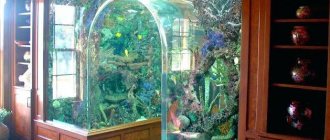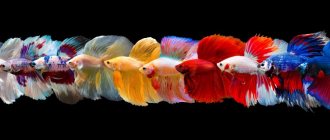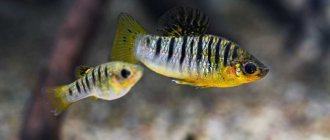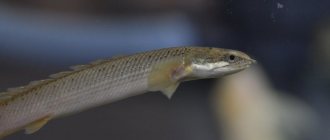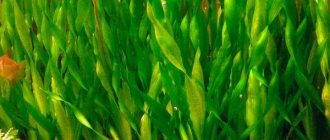Home › Aquarium plants › Catalog of aquarium plants ›
Your rating will be the first!
Eriocaulon sp. "Cinereum") is a very attractive aquarium plant that attracts the attention of aquarium enthusiasts with its magnificent color and shape. Eriocaulon is native to Southeast Asia, where it is found in rice fields, swamps and flooded areas. Currently, the plant has spread to Italy, Africa, Australia and North America. In recent years, Eriocaulon sinerium has proven its attractiveness as an aquarium plant. It is, however, quite expensive.
Description and origin
Eriocaulon sinerium is an aquatic annual plant. It grows to a height of no more than 8 cm and, due to its small size, makes an ideal foreground aquarium plant and suitable for small/nano aquariums.
The leaves are bright green, 2-8 cm long and 1-2 mm wide. The leaves are linear, sessile with parallel veins. The plant has a powerful root system, sometimes reaching triple the length of the leaves. Eriocaulon blooms with white funnel-shaped flowers, making the plant even more attractive. Flowering usually occurs from July to September under suitable conditions. Having reached maturity, the plant begins to spread freely along the bottom of the aquarium.
Eriocaulon sp. "Cinereum") was described by Robert Brown in 1810. Belongs to the Eriocaulaceae family, suborder Poaceae. There are 495 species of the genus Eriocaulon, and among them, Eriocaulon sinerium is the most suitable plant for the home aquarium. The name comes from the Greek word "Erion", meaning "wool", or more precisely "stalk".
Content
- 1 Description
- 2 Terms
- 3 Ground
- 4 Recommendations
- 5 Reproduction
Source: www.plantedtank.net
Source: i589.photobucket.com
Source: www.araflora.com
- Other names: Eriocaulon cinerium, Eriocaulon sinerium.
- Origin: Asia.
- Size: 2-8 cm.
- Temperature: 22-30 °C.
- Water parameters: pH 6–7.2, dKH 1–8 °.
- Lighting: from 1 W/l.
- Growth rate: low.
- Content difficulty: high.
Maintenance and care
| Lighting | °C | Total hardness (°dGH) | PH |
| Strong | 20-28 | 4-8 | 6-8 |
In addition to its attractive appearance, Eriocaulon also attracts with its average complexity of maintenance and care.
Eriocaulon sinerium is an aquarium plant with a powerful root system; it requires a large layer of soil up to 7 cm deep, fine fraction or sand. It is advisable to use a nutrient base or nutrient soil; Flora Base or Aqua Soil is recommended - these nutrient mixtures contain a full range of nutrients necessary for plants, including nitrates. Before planting, straighten out all the roots and cut off the ends so that the plant can take root better and form a good root system.
For normal plant growth, the aquarium must have a sufficient amount of nitrates (nitrogen), phosphates, potassium, iron and trace elements. If nutrient soil containing a full complex of macro and micro fertilizers is not used, they must be added additionally as part of liquid fertilizers. Iron and trace elements can be added with a nutrient support, in the form of tablets or clay balls under the roots of plants.
For optimal growth of Eriocaulon, lighting of 0.75 - 1 watt per liter of water with a full spectrum lamp (5000-7000K) is recommended. Lighting duration is recommended 12 hours a day. With weaker light, Eriocaulon will grow more slowly, and with strong light, the plant will become a bright green color.
Also, for good proper growth, the addition of CO2 is recommended. The supply of CO2 will contribute to the formation of a good leaf rosette, and the eriocaulon will acquire a golden hue. CO2 will also help reduce the risk of algae, which this plant really does not like.
Also, to reduce the risk of algae, remember to do regular water changes to keep the environment clean. Regular weekly changes of 10-20% of the water volume weekly are sufficient.
Eriocaulon is propagated by dividing the bush using a sharp knife or scissors.
Eriocaulon sinerium
Eriocaulon cinereum photo
Eriocaulon cinereum (Eriocaulon sp. "Cinereum") is a very interesting aquarium plant that attracts the attention of aquarium enthusiasts with its magnificent color and shape. Eriocaulon is native to Southeast Asia, where it is found in rice fields, swamps and flooded areas. Currently, the plant has spread to Italy, Africa, Australia and North America. In recent years, Eriocaulon sinerium has proven its attractiveness as an aquarium plant. It is, however, quite expensive.
Eriocaulon sinerium photo
Eriocaulon sinerium is an aquatic annual plant. It grows to a height of no more than 8 cm and, due to its small size, makes an ideal foreground aquarium plant and suitable for small/nano aquariums.
The leaves are bright green, 2-8 cm long and 1-2 mm wide. The leaves are linear, sessile with parallel veins. The plant has a powerful root system, sometimes reaching triple the length of the leaves. Eriocaulon blooms with white funnel-shaped flowers, making the plant even more attractive. Flowering usually occurs from July to September under suitable conditions. Having reached maturity, the plant begins to spread freely along the bottom of the aquarium.
Eriocaulon sp. "Cinereum") was described by Robert Brown in 1810. Belongs to the Eriocaulaceae family, suborder Poaceae. There are 495 species of the genus Eriocaulon, and among them, Eriocaulon sinerium is the most suitable plant for the home aquarium. The name comes from the Greek word "Erion", meaning "wool", or more precisely "stalk".
Eriocaulon sinerium photo
In addition to its attractive appearance, Eriocaulon also attracts with its average complexity of maintenance and care.
Eriocaulon sinerium is an aquarium plant with a powerful root system; it requires a large layer of soil up to 7 cm deep, fine fraction or sand. It is advisable to use a nutrient substrate or nutrient soil. Before planting, straighten out all the roots and cut off the ends so that the plant can take root better and form a good root system.
For normal plant growth, the aquarium must have a sufficient amount of nitrates (nitrogen), phosphates, potassium, iron and trace elements. If nutrient soil containing a full complex of macro and micro fertilizers is not used, they must be added additionally as part of liquid fertilizers. Iron and trace elements can be added with a nutrient support, in the form of tablets or clay balls under the roots of plants.
For optimal growth of Eriocaulon, lighting of 70-100 Lumens per liter of water with a full spectrum lamp (5000-7000K) is recommended. Lighting duration is recommended 12 hours a day. With weaker light, Eriocaulon will grow more slowly, and with strong light, the plant will become a bright green color.
Eriocaulon sinerium photo
Recommended water parameters for maintenance: pH 6.0-8.0; hardness 4-8 dGH; temperature 20-28 C.
Also, for good proper growth, the addition of CO2 is recommended. The supply of CO2 will contribute to the formation of a good leaf rosette, and the eriocaulon will acquire a golden hue. CO2 will also help reduce the risk of algae, which this plant really does not like.
Also, to reduce the risk of algae, remember to do regular water changes to keep the environment clean. Regular weekly changes of 10-20% of the water volume weekly are sufficient.
Eriocaulon is propagated by dividing the bush using a sharp knife or scissors.
Eriocaulon sinerium is a very architectural plant, forming a dense rosette of narrow, bright green leaves that attracts the attention of aquarists. Due to its small stature, it is an excellent foreground aquarium plant. The unique appearance of the green urchin allows you to use eriocaulon to create eye-catching areas in the aquarium. Perfectly complements the iwagumi style.
Eriocaulon sinerium video review
Cool videos about plants from FanFishki
Subscribe to our YouTube channel so you don't miss anything
PRACTICAL NOTE ON GROWING AQUARIUM PLANTS
This note is posted in all FanFishka articles dedicated to aquarium plants. This is a cheat sheet with a link that will help you grow any aquarium plant and herbalist of any complexity.
Most of the reference materials are located in the Aquascape , we also recommend our brochure: Aquarium navigator for beginners: “Underwater Gardens of Babylon” .
The formula for success in growing plants can be depicted as follows.
First of all, the proper level of lighting is necessary.
(light intensity - Lumens)
Next, the proper concentration of CO2
Further macro-fertilizers and micro-fertilizers
Water parameters, care and quality water changes
The gradation of this formula is based on the degree of importance. Lighting intensity is primary, and then descending. Therefore, if your plants have holes in the leaves, they have sciatica (crooked) or there are problems with algae, then please do not read the “bad advice” - this is chlorosis (lack of iron), this is a lack of potassium... diarrhea, phimosis and endometriosis )
You always need to solve the problem of setting up an herbalist from major to minor. Plants will die more quickly from a lack of lighting than from a lack of Fe and K. Moreover, the latter are always present in one degree or another in the aquarium, but it is difficult to measure their precise value.
Below, let's go from the main to the minor.
Lighting in an aquarium with plants . Remember, the most important thing in light is its intensity (Lumens)! All other lighting characteristics: spectrum, Kelvin, PAR/PAR, Ra... are important, but secondary. There will be no intensity of lighting, there will be nothing. At the same time, the lighting intensity must be balanced - selected specifically for your project (height of the water column, number and types of plants, daylight hours).
Based on the above, choose aquarium lighting primarily by the number of lumens, and then everything else.
Lighting is the most expensive part. The most budget-friendly solution is to install ordinary construction-street floodlights above the aquarium . Fortunately, they are now very thin and aesthetic. And believe me, under them everything grows with a bang, of course, provided that all the other components are present.
In order not to be unfounded, here are photos of our herbalists, which were grown exclusively under LED spotlights or with their presence.
If you want professional lighting or aesthetics. Then you will have to fork out some money. The amounts can vary quickly from 10,000 to 50,000+ rubles for a 100 liter aquarium. For example, in 2021 we switched to professional lighting - ISTA Titan . Yes, not cheap, but the lamps are Achon! We have grown a professional competitive aquascape under them. That’s why we advise you to pay attention to them.
Well, it’s difficult to advise anything, because... Everyone has different needs and capabilities. In this article we talk about the products of our partners - Tetra , Laguna , ISTA lighting .
We tried to briefly and objectively talk about them. Then it's up to you. In any case, we do not really recommend that you pay attention to handicraft lighting assembly from folk craftsmen. Not all, but as a rule, they shove who knows what kind of diodes into such an assembly, assemble it all on their knees... and believe me, more than once on the forum you hear echoes of the consequences of such a purchase. After all, a company is a company. At a minimum, you are given warranty and post-warranty service.
If you are a beginner, your first herbalist, then LED spotlights are your choice. Let's move on, otherwise this note isn't very short =)
CO2 for aquarium plants . The plant is approximately 90% water, the remaining 10% is dry matter. Of that 10%, 46% is carbon. This is why CO2 supply is so important in a planted aquarium.
Plants in an aquarium obtain carbon “from water” - from carbon-containing compounds. But the natural concentration of C-carbon in water is small and is only sufficient for unpretentious plants, but they, and even more so, will be happy with additional carbon feeding. The supply of CO2 can be provided using mash or a CO2 balloon system , lemon juice or other methods.
The best, professional, simple and budget option is to supply carbon dioxide through a cylinder. One thing, however, is the initial purchase of a set: a cylinder, an MG valve, a diffuser…. will hit the budget.
Is it possible to do without CO2, but for a couple of bushes of simple plants ( cryptocorynes , echinodorus , most ludwigias , etc.).
What balloon systems can you recommend? The most budget option is an assembly from craftsmen who sell CO2 systems in VK and on forums. Everything is very high quality.
If you want a branded item, then we recommend the most inexpensive and at the same time high-quality CO2 systems from ISTA (Taiwan) . We have been using them for 5 years and recommend them to you.
On sale you will find two series of ISTA Aluminum CO2 Cylinder cylinders, with horizontal and vertical threads of 1 and 3 liters.
Fertilizers for an aquarium with plants . All fertilizers, of any brand, can be divided into MACRO-FERTILIZERS and MICRO-FERTILIZERS .
Macro fertilizers are nitrate NO3 and phosphate PO4 from which plants take N-nitrogen and P-phosphorus. These are the most important elements after CO2 - C-carbon.
Remember - Redfield's proportion rules . Always keep it under control and everything will be ok. Right, based on our observations, Redfield’s proportion rules only in full NPC proportions. Incomplete proportion - without carbon C does not give good results.
Micro fertilizers . These are all the other less important elements that are necessary for plants (see link). There is no point in putting too much emphasis on them. Firstly, all of them are contained in one quantity or another in tap water and are restored in the aquarium with changes. Secondly, an overdose of micro very quickly leads to an outbreak of algae.
A common mistake made by beginners is not understanding what they are pouring into the aquarium. For example, let's take such a popular and popular fertilizer as Tetra PlantaMin . Read the product summary at the link - it strengthens, stimulates, and gives a chic body shape.
A beginner, without delving into the essence, uses it and gets an outbreak of algae, writes on the forums - “Like, wow, what a bad Tetra.” And the trouble lies not in the drug, but in a lack of understanding of the nitrogen cycle and balance in the herbalist . The beginner has a Redfield bias (let’s say N and P are generally zero) and instead of making up for the lack of these primary elements, he fills the aquarium with Tetra PlantaMin - a micro-fertilizer (iron, potassium, manganese). As a result, going over the micro is only detrimental, because... plants lack the base - nitrogen and phosphorus.
Thus, you must understand what plants lack and understand fertilizers.
How to understand what plants lack? It's simple. Now the market is filled with a variety of expensive and not so expensive aquarium water tests. We recommend inexpensive domestic ones - VladOx drop tests , they are sold online and offline.
We also recommend, let’s not be afraid of this word, innovative domestic UHE tests . They are currently only sold online.
The minimum set of tests for an herbalist is NO3 and PO4. It is advisable to have the entire nitrogen range: NH4, NO2, NO3. As well as kH and pH tests.
Tests help us monitor the situation in the herbalist, but over time it is advisable to learn to see and feel the aquarium for yourself. With experience you need to move away from “convulsive testing”; the best aquarium test and tool is ourselves.
Let's summarize this part. Macro, it’s macro in Africa too. The link above generally contains a recipe on how to make them yourself. If you are not yet ready for self-mixing, then always and everywhere you will find a line of fertilizers from Tetra: Tetra Planta Macro , Tetra PlantaMicro , substrates, root tablets and much more .
Of course, there are many other brands that produce aquarium fertilizers. There is an opportunity, use even ADA products. All markers are different in taste and color. The main thing is to use it with a clear understanding of what you are using it for and what you want to get in the end.
From the professional line of fertilizers, at an adequate price, we can recommend Prodibo (soils, soils, macro, micro, stimulants, etc.).
So, something like a note turns into the Talmud. Which is not surprising - the topic is very broad. One moment left.
Water parameters for aquarium plants. Link1 and Link2 , please look at these articles, they cover the essence quite well.
Here we note that the quality of photosynthesis is influenced by the process of caring for the aquarium: water parameters (kH, pH below 7), high-quality filtration and aeration, competent and timely water changes.
Please study
Reproduction
Propagation of this plant is not particularly difficult. It is enough just to wait for the formation of daughter plants on peduncles, and, after the formation of roots, separate them from the mother plant and plant them in the ground. Sometimes the Eriocaulon bush forms several growing points; in this case, you can carefully divide one plant into several smaller plants. It is even possible to cut the bush into several parts - each part will recover after a while and gain independence. However, the latter method is not without risk - you can destroy the plant.
Conditions
The optimal temperature range for this species is 26–28 °C. The formation of algae on Eriocaulon should not be allowed, which entails the need for constant water changes, at least once a week in the amount of 1/5 of the total volume of the aquarium. The pH reaction is only neutral and slightly acidic; it is not recommended to grow it in an alkaline environment.
The most important factor for Eriokaulon is lighting - it must be very bright, the power of LB lamps must be at least 1 W/l.
